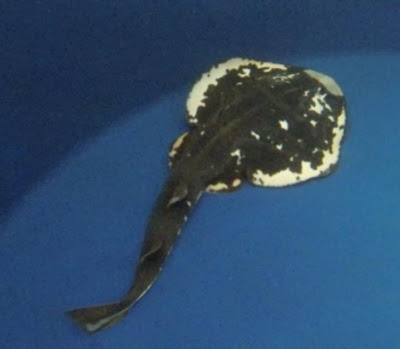 |
| Mercurana myristicapalustris Abraham, Pyron, Ansil, Zachariah & Zachariah 2013 |
Abstract
Amphibian diversity in the Western Ghats-Sri Lanka biodiversity hotspot is extremely high, especially for such a geographically restricted area. Frogs in particular dominate these assemblages, and the family Rhacophoridae is chief among these, with hundreds of endemic species. These taxa continue to be described at a rapid pace, and several groups have recently been found to represent unique evolutionary clades at the genus level. Here, we report DNA sequences, larval and breeding data for two species of rhacophorid treefrog (Polypedates bijui and a new, hitherto undescribed species). Remarkably, they represent unique, independent clades which form successive sister groups to the Pseudophilautus (Sri Lanka) + Raorchestes (India, China & Indochina) clades. We place these species into two new genera (Beddomixalus gen. nov. and Mercurana gen. nov.). Both of these genera exhibit a distinct reproductive mode among Rhacophoridae of peninsular India and Sri Lanka, with explosive breeding and semiterrestrial, unprotected, non-pigmented eggs oviposited in seasonal swamp pools, which hatch into exotrophic, free-living aquatic tadpoles. Relationships and representation of reproductive modes in sister taxa within the larger clade into which these novel genera are placed, is also discussed. These results suggest that more undescribed taxa may remain to be discovered in South Asia, and the crucial importance of conserving remaining viable habitats.
Key words: Rhacophoridae, anuran reproductive modes, Western Ghats, India, Beddomixalus, Mercurana
Beddomixalus bijui & Mercurana myristicapalustris
Two new genera of tree frogs found in Western Ghats
The discovery once again proves that the Western Ghats is a treasure trove of many amphibians
Two new genera of frogs were discovered by a team of independent researchers, led by Anil Zachariah and Robin Kurian Abraham, during their recent exploration in the Western Ghats.
The discovery, published in the latest issue of International Taxonomic Journal Zootaxa, is a joint effort by the team which comprised B .R. Ansil; Arun Zachariah of the Wild Life Disease Research Lab in Wayanad; and Robert Alexander Pyron, Assistant professor, Department of Biological Sciences of the George Washington University, U.S.
 |
Tadpole of Beddomixalus bijui
Photo: Anil Zachariah
|
Biodiversity Hotspot
The discovery once again proves that the Western Ghats, a biodiversity hot spot and UNESCO world Heritage site, is a treasure trove of many amphibians.
It was found that the newly found genera belonged to tree frog family ‘Rhacophoridae.’ The frogs were discovered in highly threatened fresh water swamp ecosystems, which are unique to the mountain range.
The frogs discovered are named after two remarkable personalities who had an association with this landscape. One genus is named ‘Beddomixalus’ after colonel Richard Henry Beddome. He was a gifted polymath of the colonial era, who made extraordinary contributions to the understanding to the natural history of the sub-continent while serving as the Chief Conservator of Forests in the Madras Presidency. His works were the first detailed forays towards a systematic and through understanding of the amphibian diversity of the Western Ghats.
The other genus has been christened ‘Mercurana’ to commemorate Freddie Mercury, late iconic lead singer of the British rock band Queen. Mercury (his pen name) was of Indian Parsi origin and had spent major part of his childhood in India in Panchagni, located in the northern part of the mountain range, where the frog now bearing his name has been discovered.
While the ‘Beddomixalus bijui’ was found in the swamp forests of the Anamalai and high ranges of Tamil Nadu and Kerala, ‘Mercurana myristicapalustris,’ is restricted to highly fragmented and threatened low land ‘Myristica’ swamp forests in the foothills of the Agastyamalai hills in Kollam and Thiruvananthapuram districts.
 |
| Beddomixalus bijui (Zachariah, Dinesh, Kunhikrishnan, Das, Raju, Radhakrishnan, Palot & Kalesh 2011) |
This distinctive forest type is dominated by wild relatives of nutmeg that thrive in waterlogged soil, and hence the name ‘Myristica’ swamp. But much of these types of forests have been lost, having been converted to raise cash crops such as rubber and oil palms, Dr. Anil Zachariah says.
Moreover, episodes of erratic rainfall over recent years are likely to affect the breeding patterns of these frogs and detailed studies are needed to explore such impacts, Mr. Abraham says.
The researchers highlight that the swamp forest and their unique biota are to be preserved. They stressed that the finding of two novel genera after more than a century of herpetological exploration in the region take the total number of tree frog genera in the Western Ghats to seven.
 |
The southern Western Ghats, home to Beddomixalus and Mercurana.
Photo: Anil Zachariah
|
 |
The lowland Myristica-swamp ecosystem, which remains water-logged for most of the year.
Photo: Robin Kurian Abraham
|
Robin Kurian Abraham, R. Alexander Pyron, Ansil B. R., Arun Zachariah & Anil Zachariah. 2013. Two novel genera and one new species of treefrog (Anura: Rhacophoridae) highlight cryptic diversity in the Western Ghats of India. Zootaxa. 3640 (2): 177–189.




















































